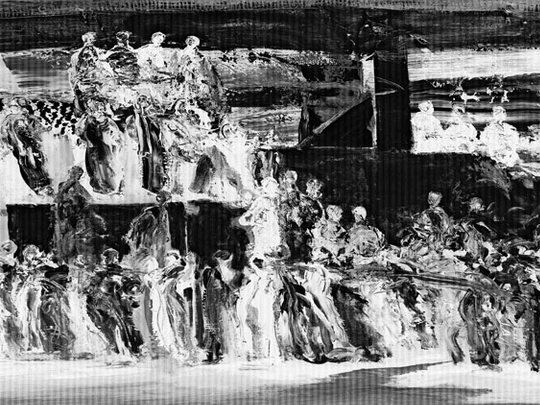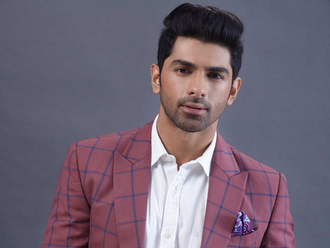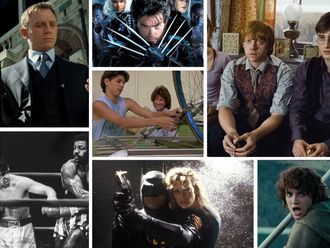
Ahmad Mualla is recognised as one of the leading Post-Modern expressionists in the Arab world. The Syrian artist is well known for his monumental and theatrical paintings and masterly use of colour. He began his career with figurative painting but is equally famous for his calligraphic artworks. In recent years, he has combined figurative painting and calligraphy to create a new and unique signature style.
But in his latest work, titled Gray Ash, the artist returns to pure figurative painting using a palette of just black and white. The series was painted in the past few months and reflects the turbulent events in the region and the present situation of flux. The canvases are monumental, dramatic and philosophical. They are filled with shadowy figures and complex narratives that blur the line between reality and fiction and between the conscious and the subconscious mind. Mualla's hazy, undefined figures ask many questions and their unfinished stories stimulate the imagination.
Weekend Review spoke to the artist about the work and the times. Excerpts:
You are known as a master of colour. Why did you choose to do this work in only black and white?
You have to be a master of painting to be able to express yourself without the indulgence of colours. For me, grey is a colour that encompasses all colours. I wanted to play with black and white to create a super-transparent effect that conveys what happens just after a matchstick has been extinguished. As an artist, I am not interested in an event at the time it occurs. I am interested in what happens just before and just after the event. In recent times, a match has been lit and I am interested in what happens after the spark dies out. Also, the grey in this series is about night-time. With our 24/7 lifestyles, we no longer have the luxury of experiencing what night-time is like in a big city. This body of work allows us to dwell in that zone.
The figures in your paintings look like biblical characters or protesters or animal-like creatures. Who are these shadowy people?
They are the people of the world. My paintings are about the struggles of mankind and I do not want them to be identified with any specific cultural group. I also never make any distinction between humans and animals. The shadowy part-human part-animal people in my work reflect the ambiguities in our minds and lives, and the fact that we are always in a state of change and uncertainty. I do not like to define the lines, and want to leave it to my viewers to decide which side of the line they want to be on at a particular moment.
How was this work influenced by the uprisings in the region and in Syria?
I am never absent from what is happening around me, whether it is in Syria, Libya, Tunisia, Afghanistan or Japan. As an artist my work is always about the times. There is no way one can run away from what is happening now. I am not a politician. I am a social commentator and I find it problematic that in Syria today things are so black and white — you are either for or against someone or something. I believe in dialogue, which is represented by the grey in my work. I do not know whether what is happening in the region will lead to something better or worse — whether the grey will lead to black or white. But my work is not limited to my region, because I believe that good art must transcend all boundaries. The whole world is in flux today and this body of work represents that flux.
Why did you choose to dedicate the centrepiece of this show to Palestinian poet Mahmoud Darwish?
I wanted to pay homage to a great Arab thinker, poet and freedom fighter who is a symbol of resistance. The eight-panel painting depicts the story of his life, which is also the story of Palestine, in a way. You can see people celebrating the revolution but also falling on the wall in Gaza. Despite dedicating his entire life to the Palestinian struggle, just before his death, he wrote a poem describing himself as a dice player, who does not know which way the dice will turn. As the Arab Spring unfolds, those words become quite significant.
Why do you never give titles to your paintings?
A title restricts the imagination of the viewers and ties the work to a certain time, place or event that may become irrelevant. These paintings could reflect what is happening in Syria today. You can see protesters on the street, people bending under barriers to move to the other side, people contemplating jumping into an unknown abyss or trying to move blocks that come in the way of freedom and progress. But I can also exhibit the same work at The Vatican, where it could be seen in an entirely different context.












